(Java, Indonesia – 25 Jan, 2014) From the island of Bali we traveled west to the much larger island of Java, crossing the Java Straight in a ratty old ugly ferry. We were told the ferry ride was a half hour, but our slow-boat rust-bucket took a full hour to chug across the gap.
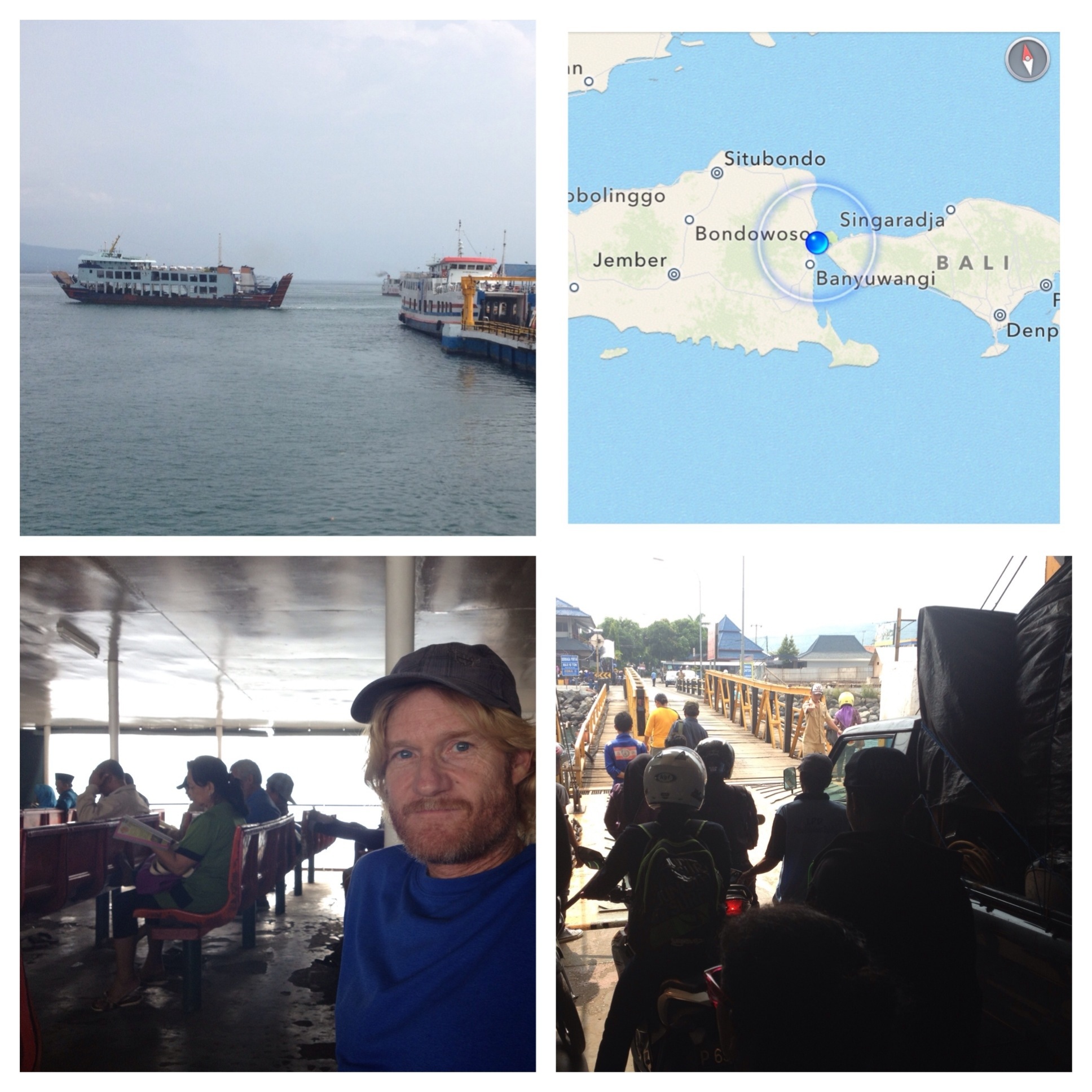
Before boarding, I was accosted two different times by friendly locals. They asked where we were from, what’s my name, etc. Nothing too notable. In the end, I was handed a card of their friend that runs tours to the nearby volcano- Kawah Ijen -in case I was interested.
Just as we exited the ferry on the Java side, weaving our way off the dock amid the motorcycles, cars and trucks, a little guy approached me and asked, “You are Gary from America?” He introduced himself as “Pepe” and started chatting us up (in pretty good English) about our plans. Obviously, he’s the ‘friend that runs tours’ to the volcano, having been called or texted by his scout on the Bali side. Being ambushed in this way was a little disconcerting, but ultimately harmless. Pepe was a young guy and outgoing as hell. Clearly entrepreneurial and a fast talker but never pushy. We actually enjoyed talking to him and he helped guide us to the “bemo” (local van-bus) that took us to our hotel.
Java Vibes
Unlike the Island of Bali, Java is predominantly Muslim. That alone changed the whole vibe. Seeing nearly every female above 12 wearing a headscarf brings forth a mixture of unpleasant emotions- discomfort, disappointment, even low-level anger. It’s the subjugation of women on an industrial scale protected from scrutiny by the shield of religion. I freakin’ hate it! To be clear, the Muslims we saw in Indonesia did not wear burkas (the black full-body cloak), but they all did wear a headscarf to hide any trace of their hair. Sure, head scarves are less bad than burkas, but they’re both symbols of suppression and control.
Last word on it…. Islam is only shades different from any other religion. They all have their bronze-age rituals and beliefs that require leaps of faith that attempt to build bridges from the rational to the magical. While no religion is all bad, some are definitely worse than others. I count any religion that requires its followers to wear funny hats, grow bushy beards or curly sideburns, or dress in any particular way to be among the most offensive.
Now that my anti-religion rant has concluded, I can add that never did we meet anyone in Java (Muslim or non-Muslim) that was anything less than nice and helpful towards us.
Here’s one of the many mosques we zoomed past while in Java.
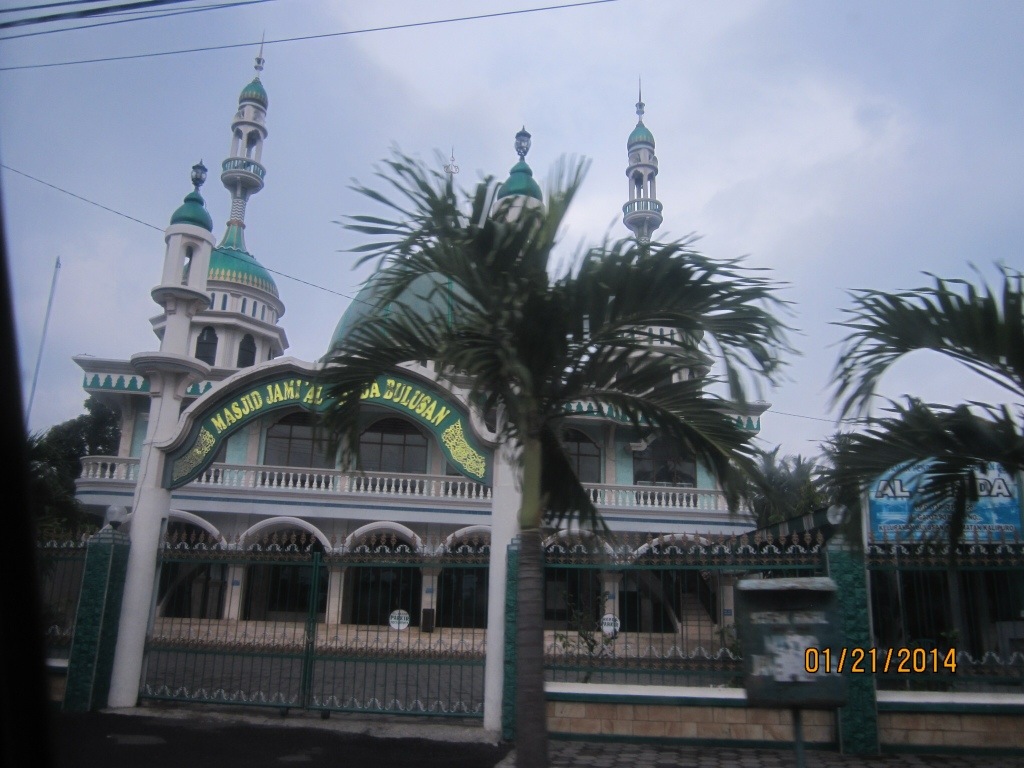
The city closest to where the ferry delivered us was Banyuwangi; not a tourist destination for good reason. The one night we stayed there was plenty. The other downer was that we couldn’t find a way to squeeze in that hike to the Ijen volcanic crater. Pepe’s tours started at 1 AM! The reason for the painfully early start is to put you at the crater’s edge before the sun rises, the only way to catch a view of the blue flames rising from the toxic steaming waters that fill the crater’s mouth. Unfortunately (or fortunately), we never saw any of this because we couldn’t go up to the crater and back before our train departed Banyuwangi for Yogyakarta, the final destination of our visit to Indonesia.
Borobadur- Over 500 Buddhas Strong
We spent about 9 hours on trains crossing Java to reach Yogyakarta. At least a very impressive treasure awaited us… and that was Borobadur- the largest Buddhist temple IN THE WORLD. It was built over about a 100 year period sometime between the 8th and 9th centuries A.D. Stone by carefully sculpted stone, the temple rose above the landscape, the Buddhist’ grandest physical contribution to the world of religion.
Walking towards the monument, we turn around for a pic.
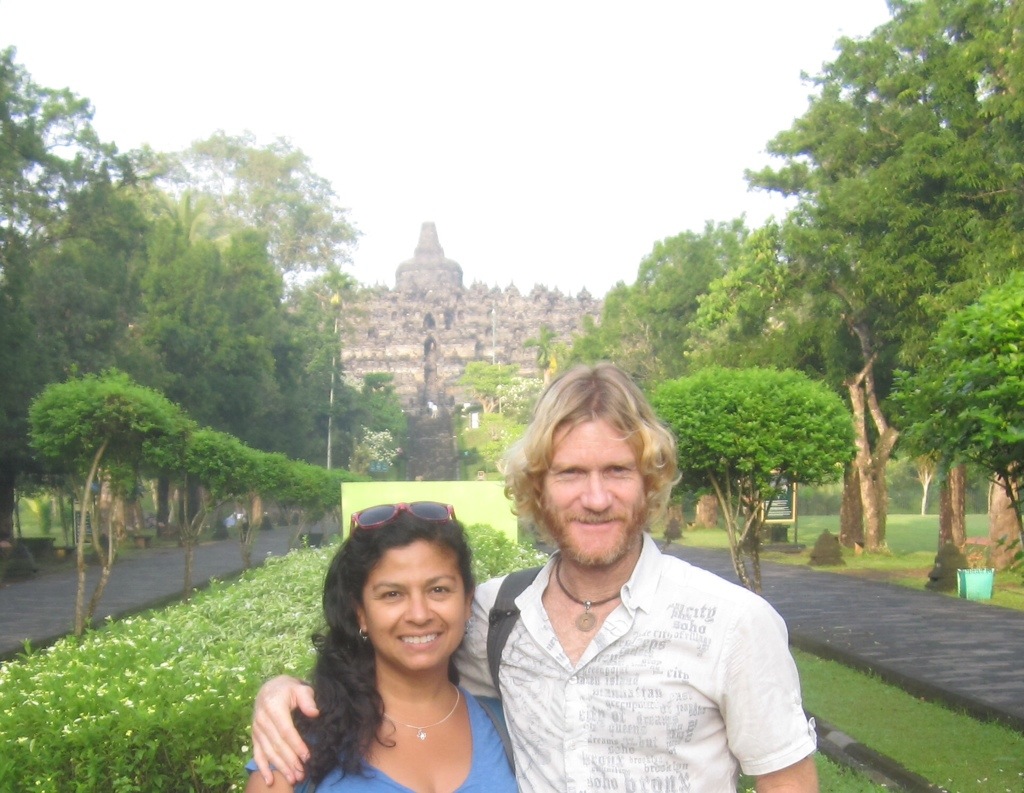
The monument has the general shape of a pyramid, four sides, rising to a peak at its center. However, the structural intricacies abound within each of its four levels. For example, the walls on either side of the inner walkways are carved with the history of Buddha in storyboard form.
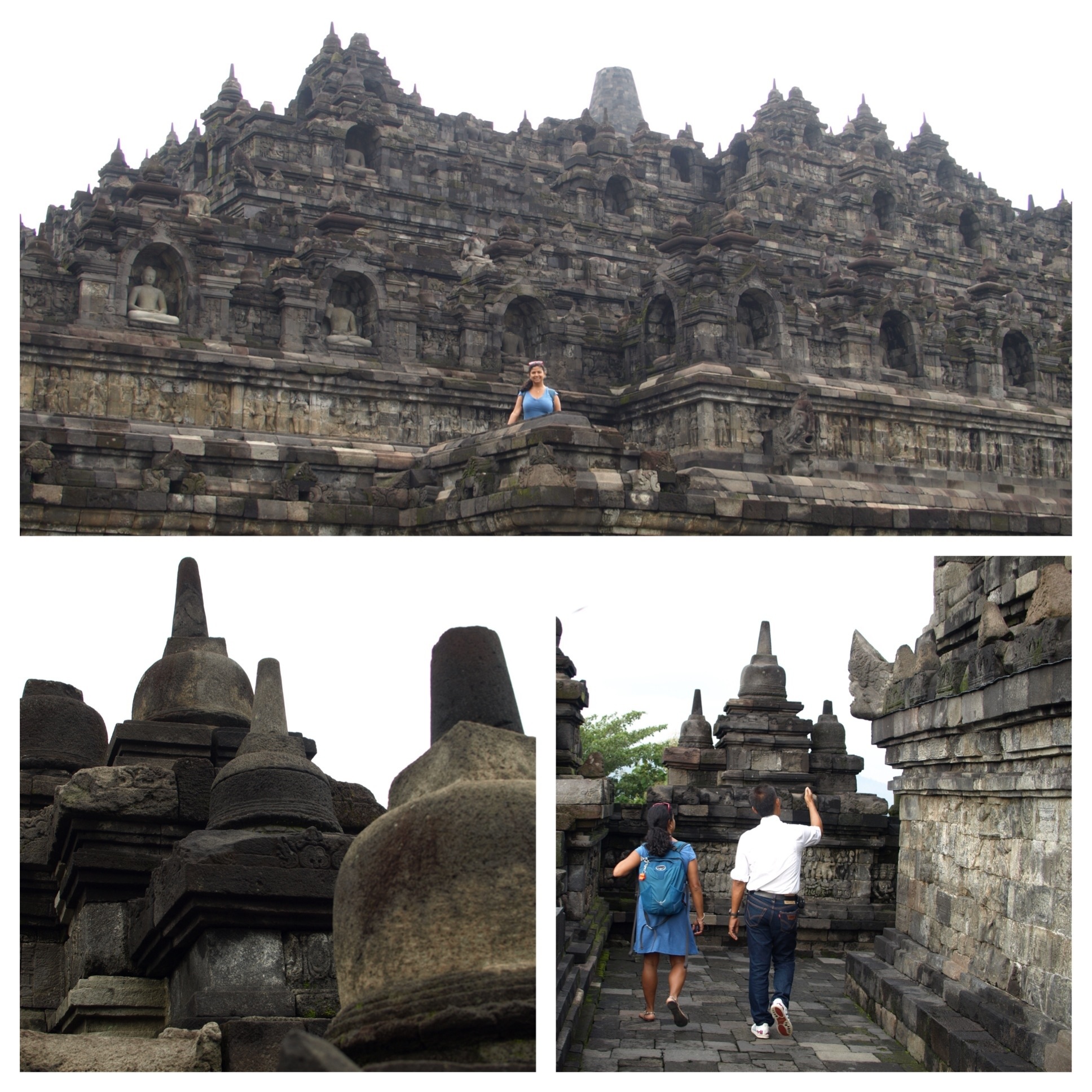
Here is our guide explaining how the story of Buddha is carved into the walls that line the monument corridors.
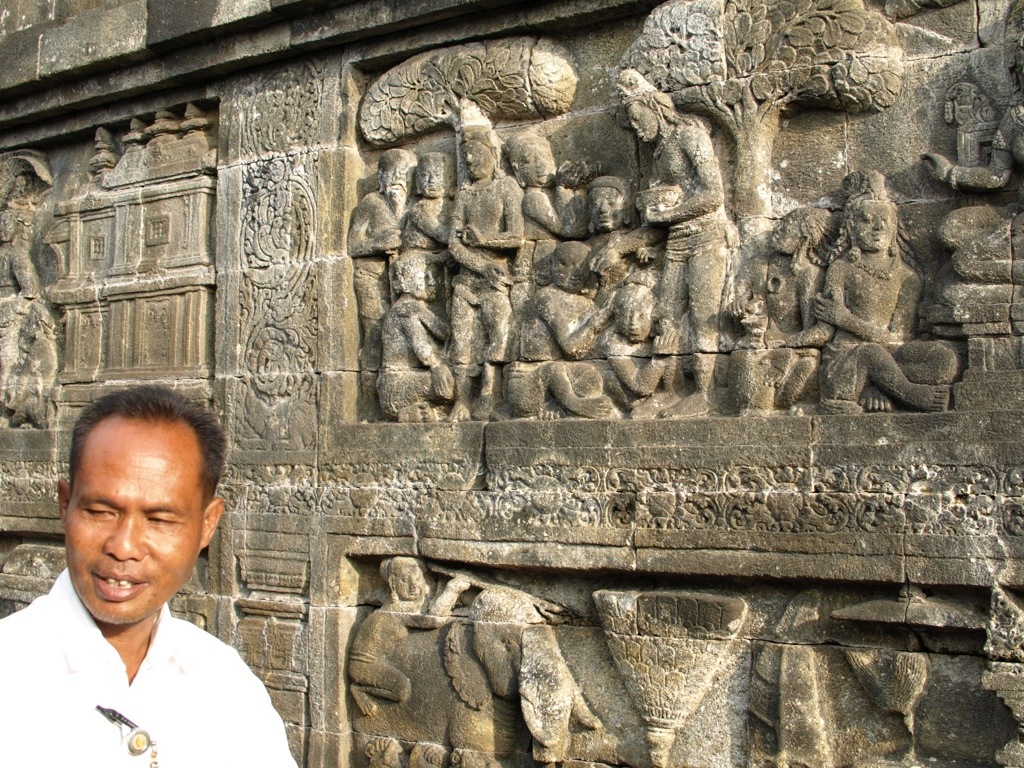
Following the complete path to full enlightenment, in other words, starting at the bottom and walking around and up the entire monument, would cause you to cover a distance of about 5 kilometers (3 miles).
All of the Buddha statues look identical at first glance, but a closer look finds the positioning of their hands vary depending on what level of enlightenment is being represented.
I’m standing on about level 3. The circle of stupas (that’s what those bell-shaped things are called) starts on level 4.
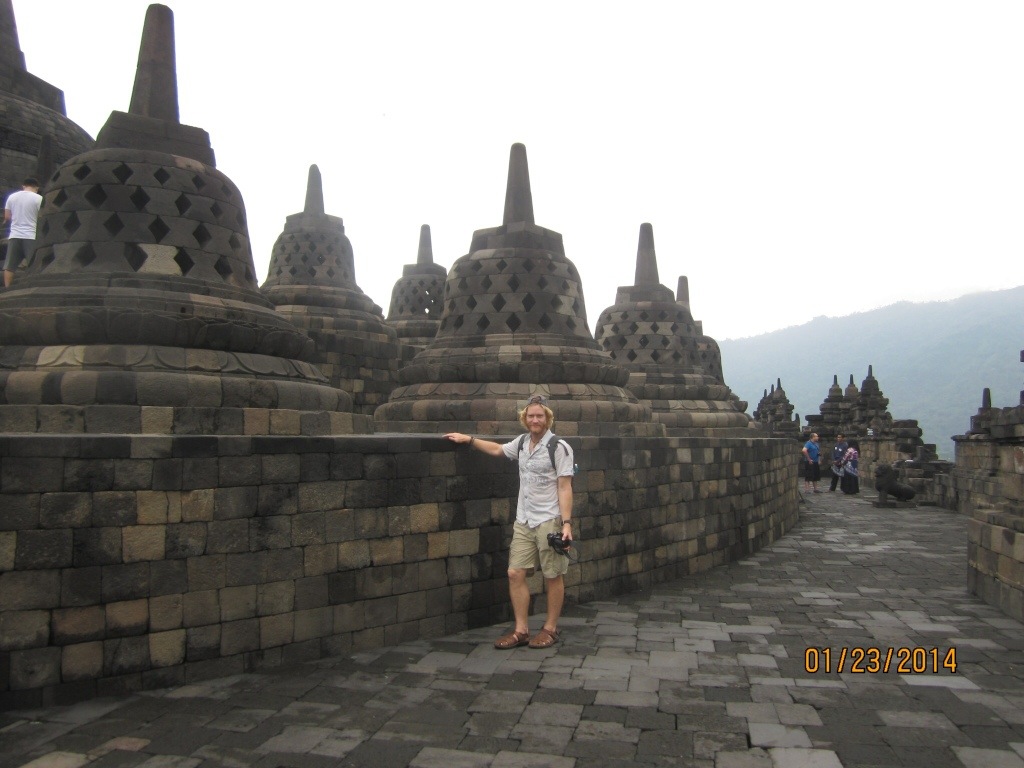
There are Buddha statues on every level and facing outward on every side. Altogether, there are over 500 hundred statues of Buddha precisely placed throughout the site. This guy sure has a lovely view.
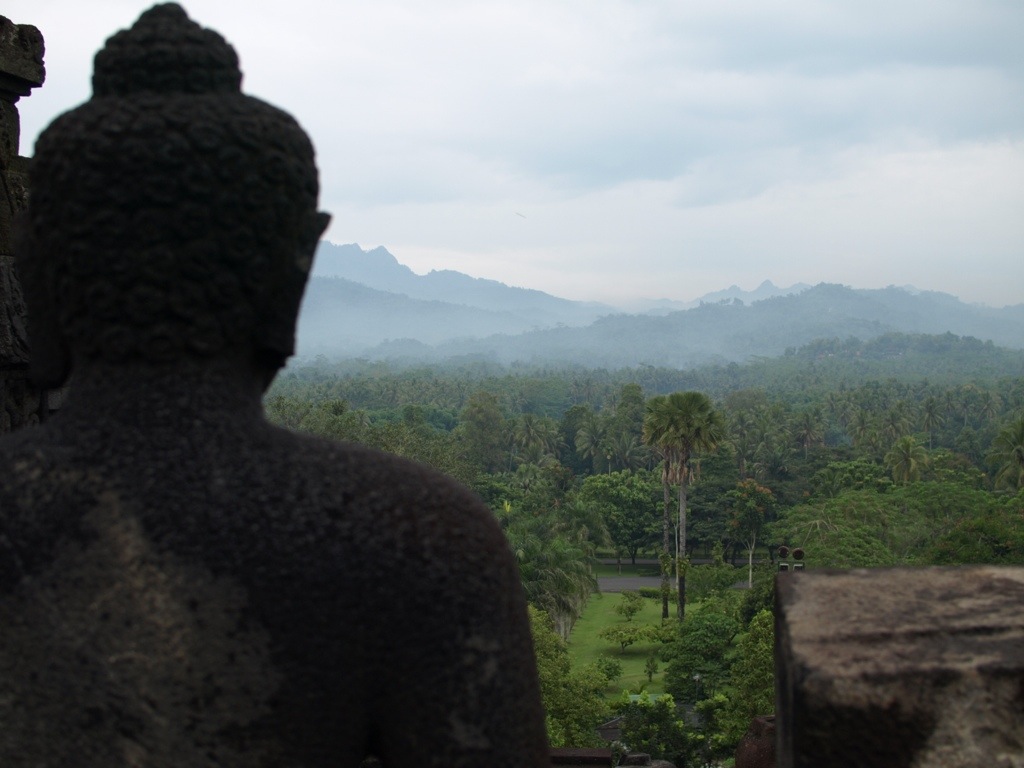
A group of kids enrolled in an English class asked me to be in their group photo.

Inside each stupa is a Buddha statue. One of them is displayed without its topper to give visitors an unobstructed view of the meditating master.

Jessica stuck her camera inside a stupa and caught this Buddha in mid-meditation.
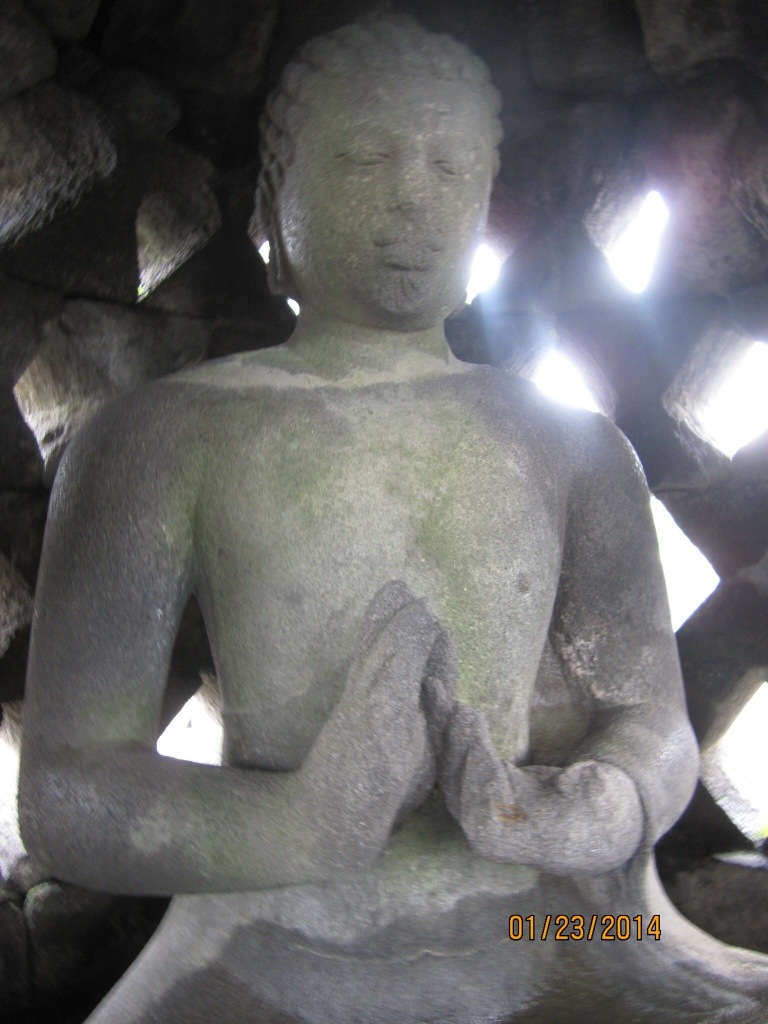
Many of the Buddhas have lost their heads over the past many centuries.
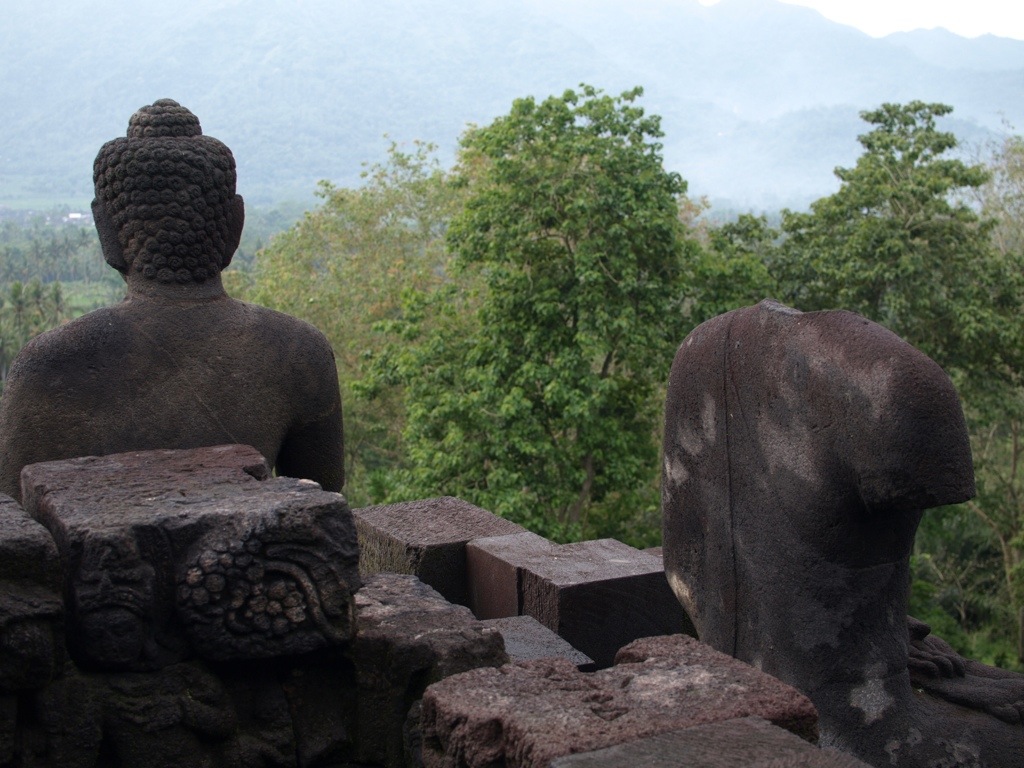
Also of great interest is the fact that Borobadur lay unknown and hidden from the world until it was ‘unearthed’ by a Dutch engineer in 1814, buried beneath layers of volcanic ash and dense vegetation. How it came to be that Borobadur was abandoned and allowed to deteriorate so much that it literally disappeared from view is largely a matter of speculation. My money says a close succession of volcanic eruptions in the area caused the local population to give up on it and relocate to Bali.
The photos we took do an overall poor job of communicating the true brilliance of Borobadur. The dark stone from which it was built could be interpreted as giving it an ominous tone. In person, it is grand and simply amazing in only a positive way.
Bird Market
Yogyakarta is a busy city with a lot going on. There is even a bird market. (If your brain just said, What’s a bird market?, No worries; ours did too.) We strolled through this interesting and smelly outdoor pet store on a Friday afternoon not knowing what to expect. We saw lots of birds for sale, but there were large stalls containing tanks full of fish, too. Down another aisle and it was cats and dogs for sale. A short turn to the left and there was a cage occupied by three fruit bats. A guy told us the bats are sold to people who have asthma. I forget which part of the bat they ate to cure their asthma, but I don’t think I care to remember anyway. A few more steps and we ran across large cages containing huge boa constrictors. What’s next, giraffes?
The whole place wasn’t that big and it didn’t take long before we were ready to go…driven out by the sadness of seeing animals in cages and by the sometimes awful smell. But then we noticed a larger gathering of people towards the back of the market. Curious, we walked towards the people and wound up stumbling on a songbird competition. What the PEEEEEP?! Who knew such a thing existed? (Not us.)
Every Friday, songbird owners and trainers (yes, each bird has its own “trainer”) enter their bird into the venue to be scored by a band of judges for their singing abilities. The bird who captures 1st Place can win up to $1,000 for its owner. We stood ringside for the crudely run spectacle and were thoroughly flabbergasted by the whole thing. We saw (and heard) several rounds of the competition with different species of birds competing. The classic Canary was the only bird name we recognized.
Birds were judged on how actively they sung and the quality of their song, too. Birds who get stage fright won’t go far in this arena. It’s pretty hilarious to see the trainers trying to wave signals to their birds in order to get them to sing better/more.
Sultan’s Palace
A real live current-day Sultan lives in a palace in Yogyakarta…and we went there. The palace is open to the public and one day we hitched a ride on an becak (equivalent to a pedi-cab in the states) to pay the Sultan a visit. Riding in the becak was an adventure all its own. Those drivers have no fear of death and will pedal out into the street on faith (and stupidity) alone.
Yogyakarta is the only city/province of Indonesia to be governed by a Sultan. Today the Sultan and his family have only ceremonial duties, but it wasn’t so many generations ago that the Sultan’s word was law. Based on our visit to the Sultan’s Palace it seems many of those laws were designed to bring benefit to himself….and his many wives.
The collage below shows the entrance to the courtyard, the Sultan’s residence, and the biggest drum I’ve ever pounded on. Back in the day the drum was used as an alarm. Thumping on it makes a low-pitched tone that can be heard over great distances.
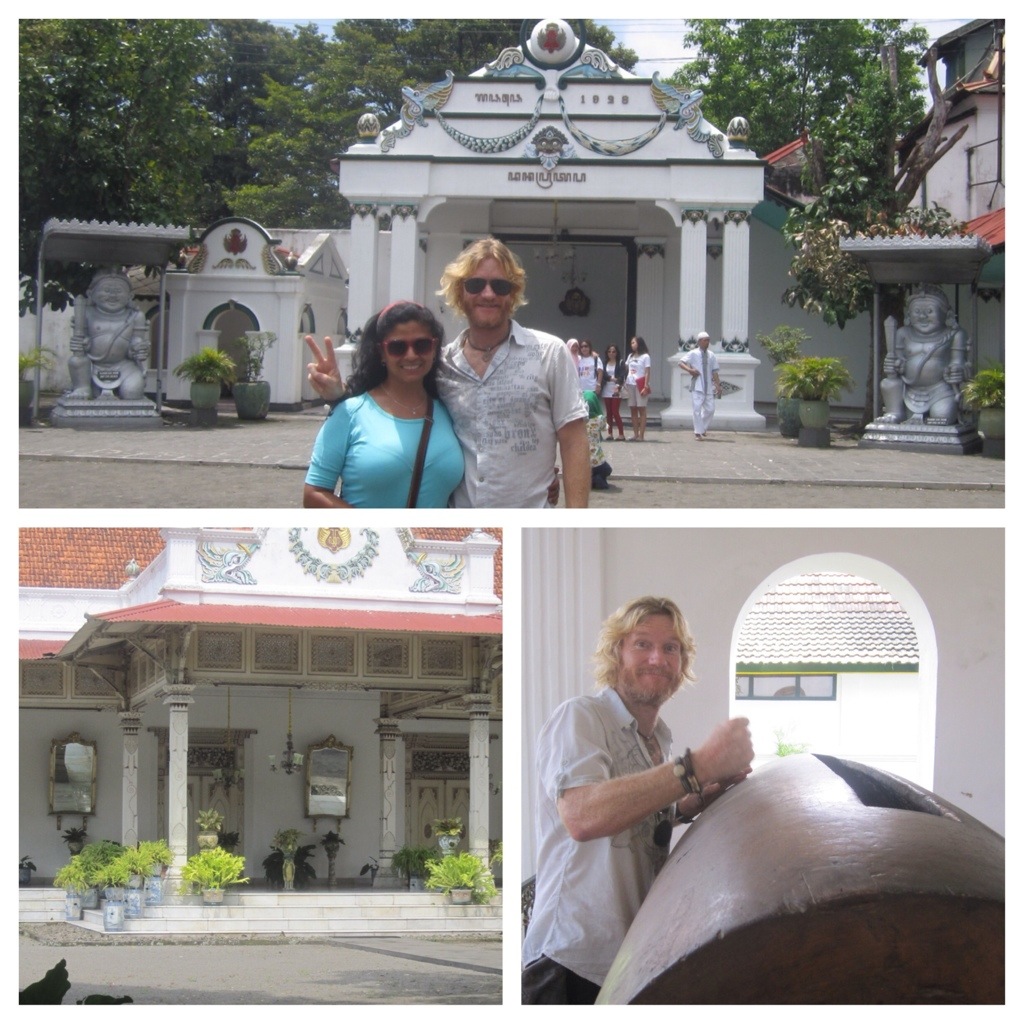
Most interesting was to see the Sultan’s swimming pool. It was actually in quite a poor state of repair, (so hard to find good help these days), but you could see the Sultan’s tower hovering over one side of the pool. Supposedly, the creepy Sultan would lurk up in the tower and pick out his next wife from the bathing beauties in the pool below.
“Where Does It Come From?”
In the neighborhood of the Sultan’s Palace there was a big open grassy area. I hesitate to call it a park, because it honestly wasn’t nice enough to qualify as a park, in my snobby opinion. My snobbery notwithstanding, the locals made good use of the space- playing soccer and other games on it throughout the day. At night the park took on a festive atmosphere. These neon-lit pedal cars are for rent.
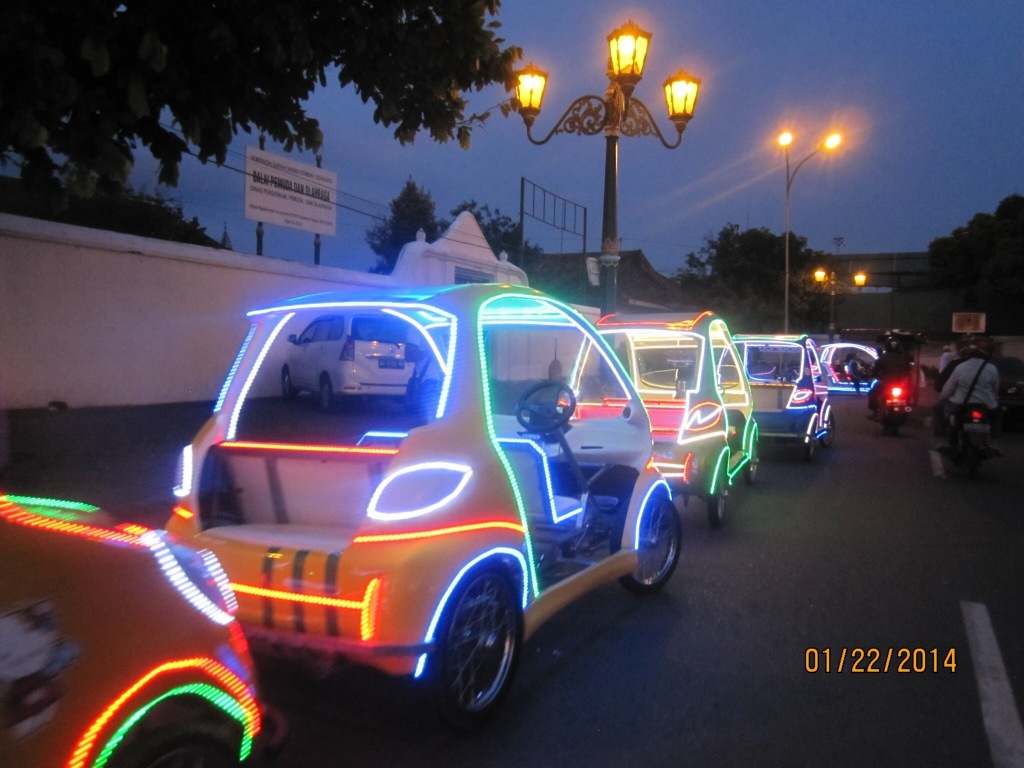
One afternoon, I went to the grassy area with my frisbee to see if I could find someone to throw with. A group of about 7 young guys were walking around the park and I motioned with my Frisbee like I was tossing it to them. Soon they were all involved in throwing the Frisbee around like small children. A couple of them spoke a little English and after some time one of them pointed at the Frisbee and asked, “What is this?” “Where does it come from?” I didn’t understand what he meant at first, but it became clear once he told me, “It’s my first time to see this.” Wow!
They were having a blast throwing it around, but were comically bad at it.
One thing we noticed frequently about men in Indonesia, most of them carried what could most accurately be described as a purse or handbag. These cases were more masculine than a typical purse, but clearly served the same function- a place to keep your things. It was funny to see the guys running to catch the Frisbee, but first asking their friend to hold their purse.
While I was teaching Ultimate to my new friends, Jessica was making a few friends of her own.
Indonesia is not a typical vacation destination for Americans, but perhaps it should be. It has so much to offer and is absurdly inexpensive. It’s the kind of place one could explore for months on end and still leave wanting more. For us, and for this pass through the area, our two weeks in Indonesia must suffice… for now we move on to Singapore and then Hong Kong. Stay with us.


